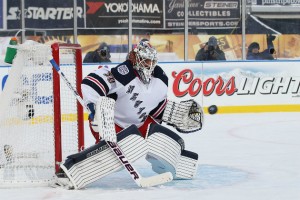Despite being Ben Scrivens’d (again) last night, the Rangers have been on quite a roll for past six weeks or so. Most will point to the terrible 5-3 loss to the Islanders on December 20th as the game that proved to be a turning point for the season. At that time, the Rangers were struggling to break .500, playing downright terrible defense, and saw fans calling for AV’s head. But most vexing was the play of Henrik Lundqvist.
Since that dark time, the Rangers have played much better hockey. The team went on 15-6-1 stretch of dominance, the system seems to have sunk in for the players in a meaningful way and the play of their King greatly improved. During the beginning of the season, we were all left scratching our heads at how the Henrik could look so mortal after another Vezina nominated (half) season. Some pointed to the new equipment restrictions, I was curious about his new super-lightweight Bauer pads, but he seems to have put it all to rest.
The eye test will tell you he has played better over the past six weeks, but I didn’t realize how phenomenal his numbers over that stretch really were. We’re talking a 1.86 GAA and a .940 Save Percentage. While not the largest sample size, still, very impressive work leading up to the Olympic break. The question that was ultimately begged for me over the past few weeks is: what has lead to Lundqvist’s turnaround?
I noted at various points earlier in the season both here on the blog and on Twitter that Hank had fallen victim to some seriously awkward lateral slides and found some goals squeaking through his body that we are not accustomed to. As a general rule, when pucks are finding their way through holes (under the arms, through the five-hole, between the bottom of the gloves and tops of the pads) it is almost always a balance issue.
As a goaltender, balance is hugely important. When your balance is on, you sit comfortably in your hip flexors with your chest forward and your weight on the balls of your feet. This allows for even weight distribution across your entire body mass. This is the key to save execution, whether it is stationary or lateral. Balance can be offset by any number of body parts, but it is usually corrected by your core balance, and compensated for by your limbs. To correctly re-align your balance, your back end and your chest need to be positioned correctly, because they are the heaviest parts of your core. When this alignment is off, your arms or legs will try to make up for the imbalance, and you start to look like Craig Anderson.
In Hank’s case, that excess arm movement to correct his balance issues was allowing pucks to slip through holes he would normally seal air-tight to his body. To explain the lateral movement issues, his weight was clearly too far forward as he slid, which resulted in his torso ending up along the ice (along with his face). When this happens, not only does your surface area suffer, but your sliding distance and accuracy does as well (also known as Roberto Luongo syndrome).
What we have noticed recently is a natural correction of Hank’s balance and stance. It could be getting used to the reduced weight of his new equipment, it could have just been a lack of comfort in the new system around him, who knows?. Unless he is willing to explain it (hint: he isn’t), we can only speculate as to the cause, but we can take solace is knowing that he seems to be correcting this mechanical inconsistency and is well on his way back to finding his Vezina winning form. Hopefully his strong play continues through the Olympics and the stretch run, but we at least have a tangible observation to support the turnaround in his play. I’m sure tireless hours have been spent with Beniot Allaire to correct this issue, and it seems that work is paying off.
Share:
More About:Goaltending

